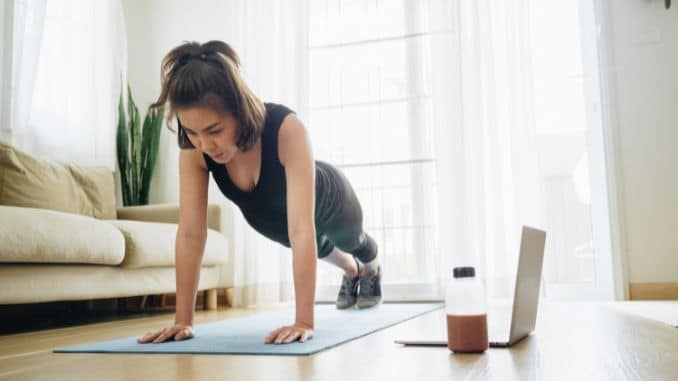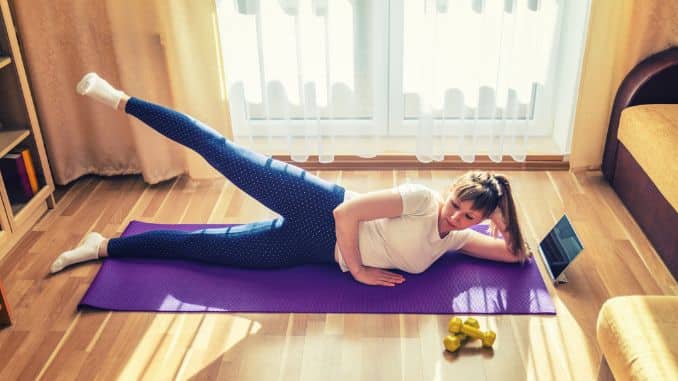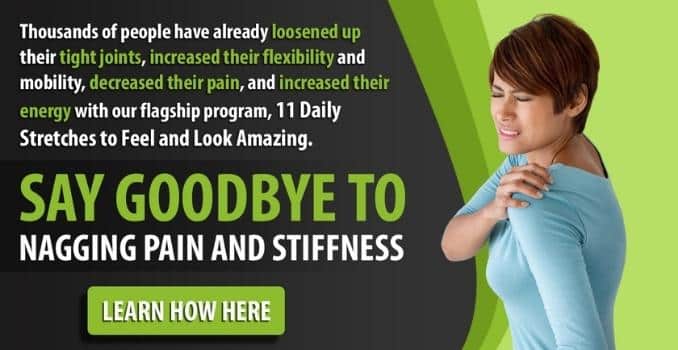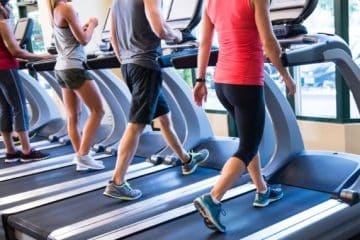For many individuals, the idea of a home workout can be intimidating. They may have concerns about how to exercise without equipment or in limited space. However, there is no need to worry. Home workouts offer numerous advantages and can be done anywhere. They are ideal for those new to exercising and may feel hesitant about going to a public gym. In addition, home workouts provide more flexibility with your schedule and help you stay motivated by incorporating fitness into your daily routine. Achieve the desired results for your abdominal muscles and engage in intense cardiovascular workouts without having to step outside your own house.
Importance of In-Home Workouts for Beginners
Exercising at home offers a range of advantages, beginning with the comfort and privacy it provides. This setting especially appeals to beginners who may feel self-conscious about working out in public spaces like gyms. The convenience of in-home workouts cannot be overstated, as it eliminates the need for time-consuming commutes to a gym or fitness center, making it easier to fit a good form of exercise into a busy schedule.
Beginners can choose home exercises and timings that fit their schedules, making it easier to develop consistent exercise habits. Home exercises are cost-effective and don't require expensive gym membership or specialized equipment. Distractions are minimized in this environment, allowing beginners to focus better on their workouts and form. Personalizing exercises to individual needs and fitness levels helps beginners progress comfortably and confidently.
Starting with simple beginner home workouts, such as weighted and bodyweight exercises, also lowers the barrier to entry in-home workouts for beginners and those new to exercise, providing an accessible entry point into a healthier lifestyle without feeling overwhelmed. The long-term sustainability of in-home workouts is a significant benefit, as beginners can establish a habit of regular physical activity; like bodyweight exercises, that can be maintained for years to come. Despite having limited equipment, exercising at home provides many health advantages, such as shedding pounds, enhancing heart health, boosting muscle strength and flexibility, increasing muscle mass, and promoting overall wellness. With all these advantages combined, working out at home proves a beginner workout to be an excellent choice for beginners and seasoned fitness enthusiasts.
Exercises and Weight Loss

Home workouts are a great starting point, especially for beginners and those who want to lose weight and build muscle. These exercises use your body weight for resistance and target different muscle groups to help you gain strength and endurance. Some simple bodyweight exercises to try are push-ups, squats, and lunges. For upper body strength, include exercises like bench presses and handstands with hands shoulder-width apart. Consider planks, side planks, and mountain climbers to engage your glutes and core. Proper form is important to prevent injuries, so consult fitness experts or a personal trainer if needed. Regular exercises burn calories, improve health, and support weight loss.
Below are some in-home workouts for beginners exercises that you can easily do at home, and you can do this every once a week, depending on your schedule.
Warm Ups
1. Shoulder Rolls
Get started by standing upright with your feet hip-width apart, maintaining good alignment with your head, shoulders, hips, and legs. Place your hands on your sides and engage your core. Shift your shoulders upward, then roll them up and back until you feel resistance in your shoulder blades. Relax and repeat the movement in the opposite direction. Complete 10 reps in each direction. This exercise is a perfect addition to your beginner home workout routine, helping you improve posture and upper body mobility.
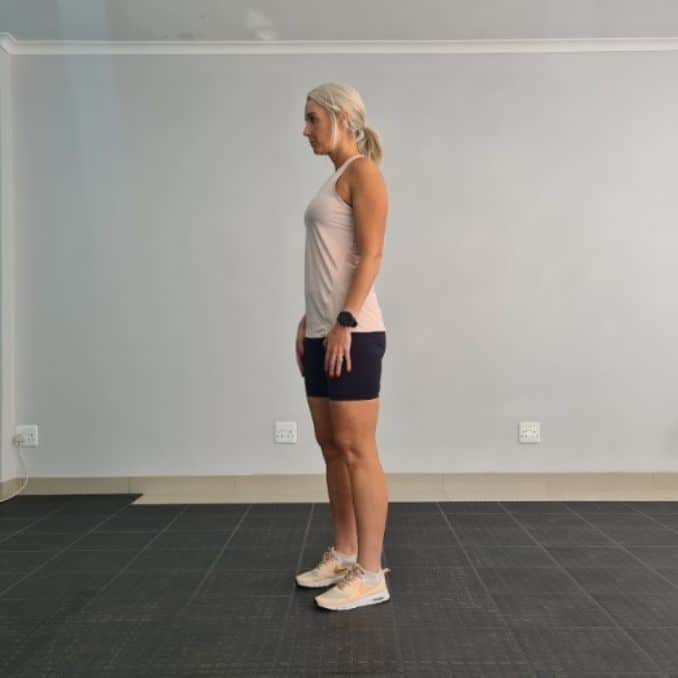 |
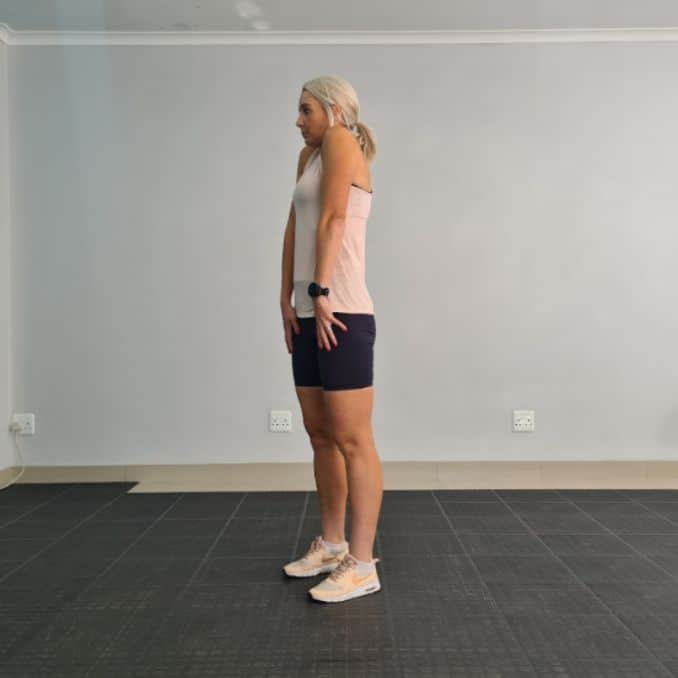 |
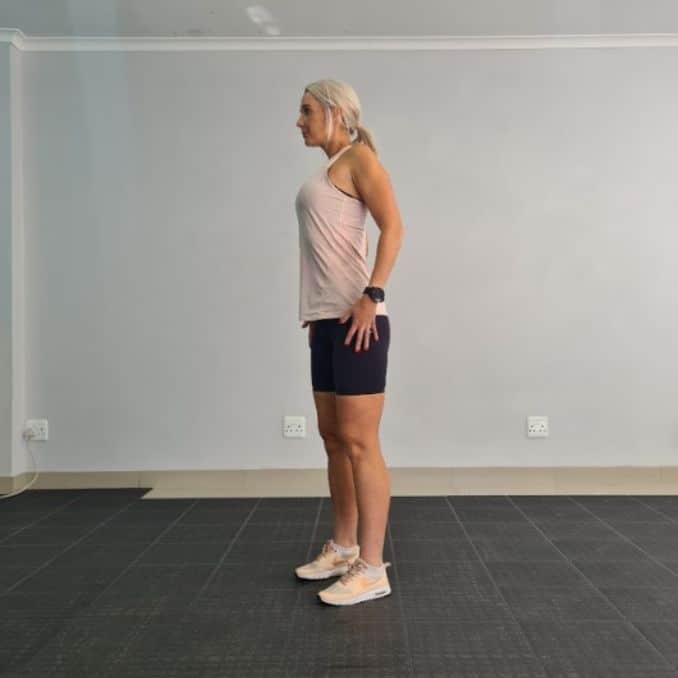 |
Shoulder Rolls
2. Standing Twists
Get started by standing upright with your feet shoulder-width apart, maintaining good alignment with your head, shoulders, hips, and legs. Extend both arms in front of your body at chest height with your palms pressed together. Tighten your abdominal muscles. Twist your upper body as you open one arm out to the side, keeping your hips locked in the forward position. Return to the starting position and repeat the movement on the opposite side. Complete 10 reps. Incorporate this exercise into your beginner home workout routine to enhance core strength and torso flexibility.
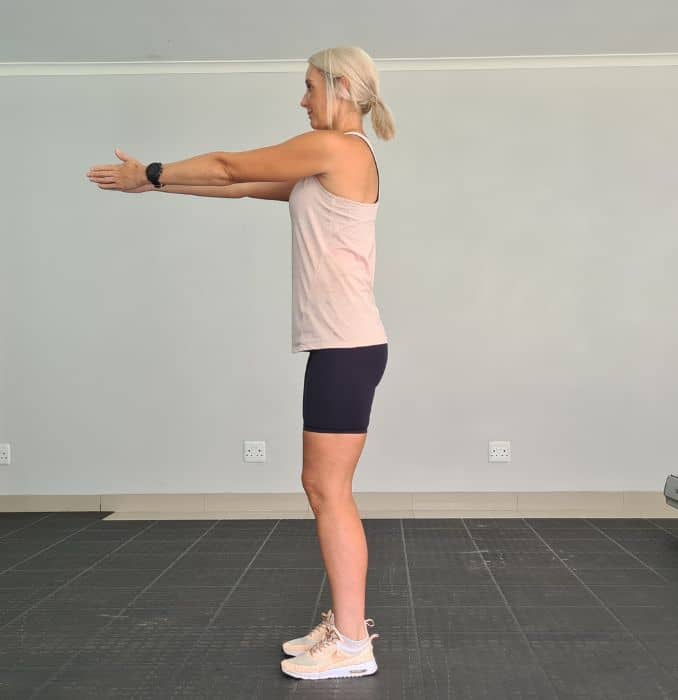 |
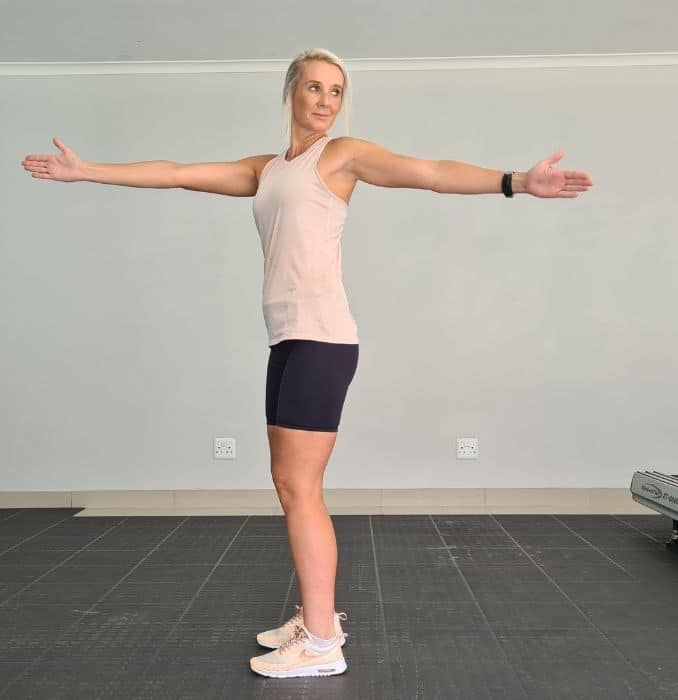 |
Standing Twists
3. Arm Raises
Begin in an upright standing position with your feet hip-width apart, maintaining good alignment with your head, shoulders, hips, and legs. Place your arms at your sides. Tighten your abdominal muscles, and raise one arm overhead while the opposite arm remains at your side. Repeat the movement, alternating sides. Complete 10 reps. This arm raises exercise is another effective component for your beginner home workout routine.
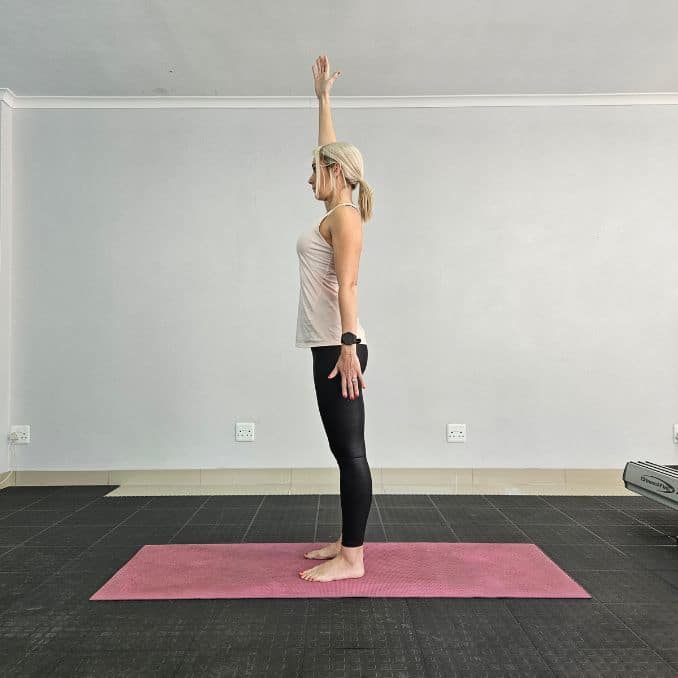 |
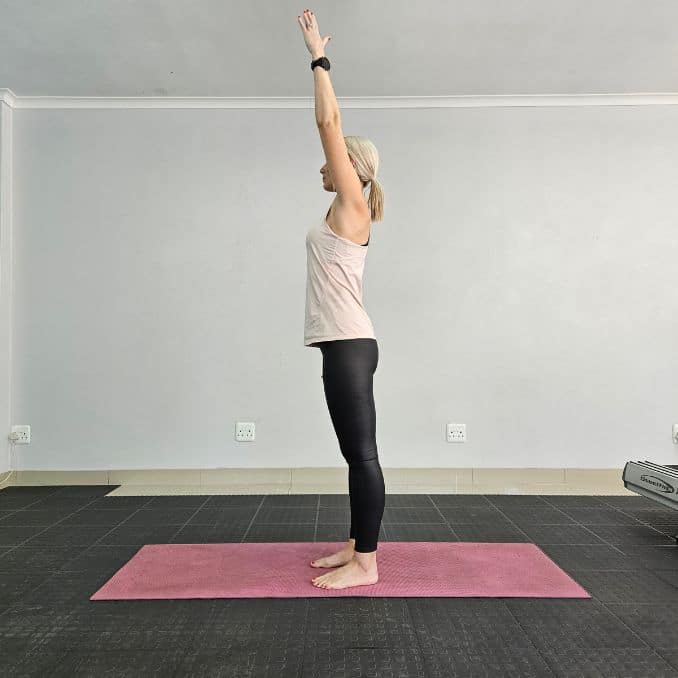 |
Arm Raises
4. Bodyweight Chest Fly
Begin in an upright standing position with your feet hip-width apart, maintaining good alignment with your head, shoulders, hips, and legs. Bring your hands in front of your body. Engage your core and open both arms out to the sides, ideally up to shoulder- height. Lower your arms back to the starting position and repeat the movement. Complete 10 reps. Including bodyweight chest flies in your beginner home workout routine can help strengthen your chest muscles and improve upper body stability.
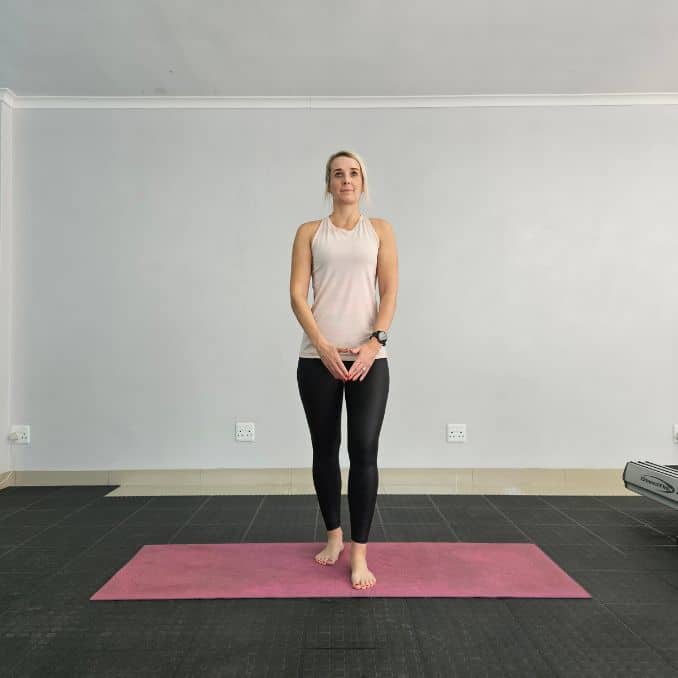 |
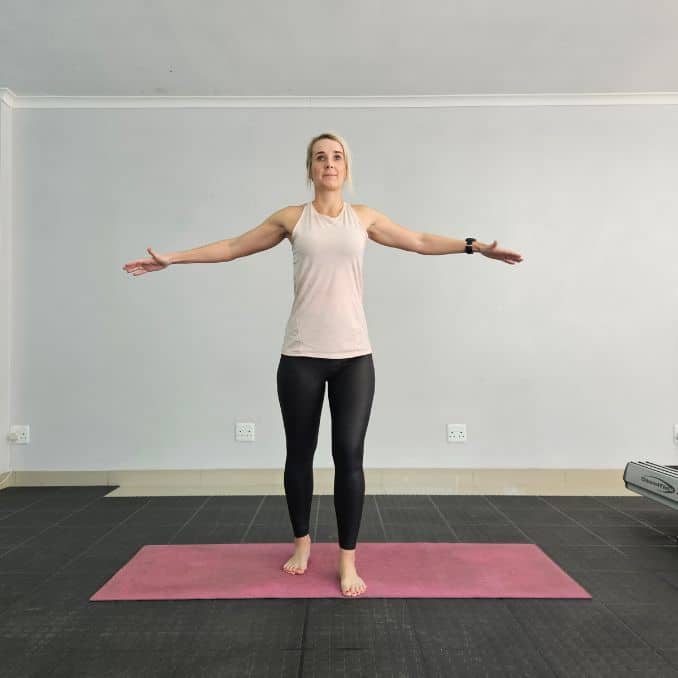 |
Bodyweight Chest Fly
Routines
1. Shoulder Flexion
For this exercise, use dumbbells or cans of soup for added weight.
Begin in an upright standing position with your feet hip-width apart, maintaining good alignment with your head, shoulders, hips, and legs. Hold a dumbbell in each hand and engage your core. Raise one arm in front of your body, ideally up to head height. Lower your arm to return to the starting position and repeat the movement on the opposite arm, alternating back and forth. Complete 5 reps on each side. This shoulder flexion exercise, utilizing added weight, is an excellent choice for your beginner home workout routine.
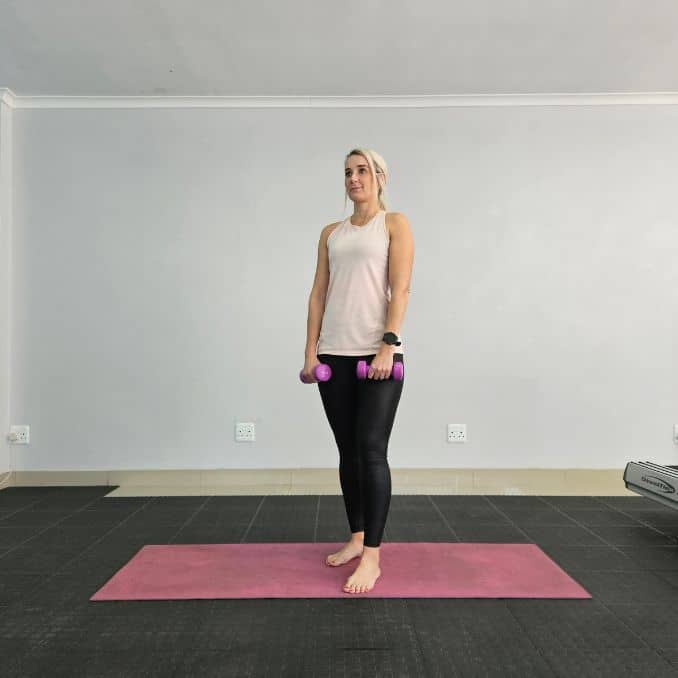 |
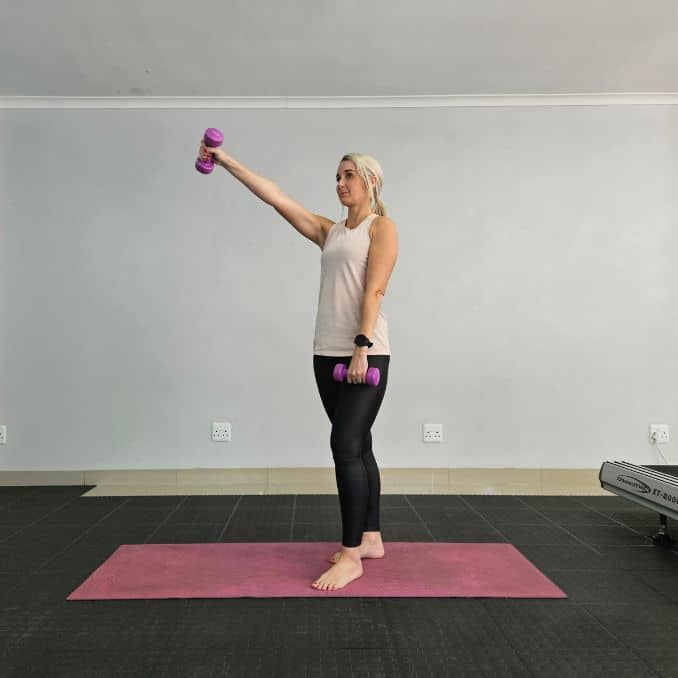 |
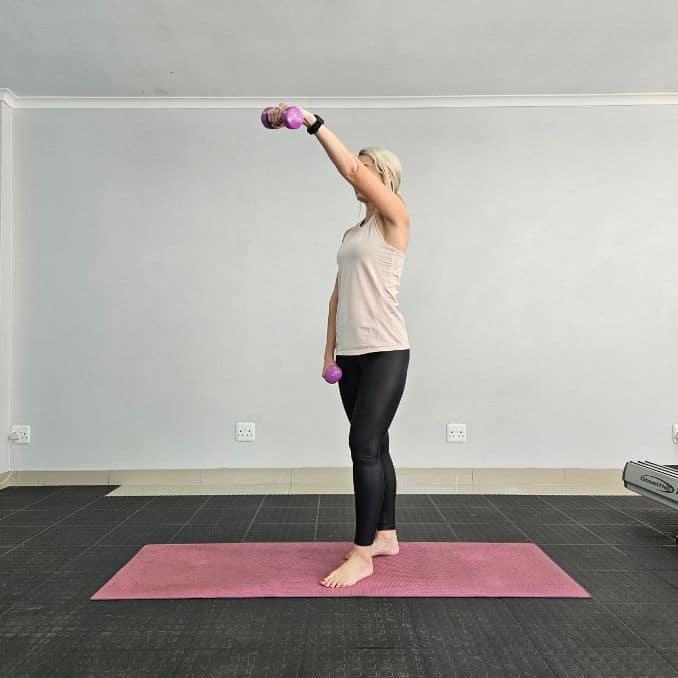 |
Shoulder Flexion
Benefits of Shoulder Flexion
Shoulder flexion exercises offer numerous advantages, primarily enhancing upper body strength. These exercises engage various shoulder muscles, such as the deltoids, pectoralis major, and biceps, improving muscular endurance and power. This is especially beneficial for activities involving pushing motions like overhead lifting or handstands.
Regularly practicing these movements expands your range of motion, facilitating everyday movements and tasks with greater ease. Whether reaching high shelves or dressing without discomfort, improved shoulder flexion significantly impacts daily life.
-
Promote Better Posture and Alignment
Countering the negative effects of prolonged sitting or hunching over electronic devices. Desk jobs often lead to rounded shoulders and a forward head position; however, strengthening the muscles involved in shoulder flexion helps maintain an upright posture. This improves appearance, and strength training prevents potential musculoskeletal issues caused by poor posture.
2. Triceps Extension
For this exercise, use dumbbells or cans of soup for added weight.
Begin in an upright standing position with your feet shoulder-width apart, maintaining good alignment with your head, shoulders, hips, and legs. Hold a dumbbell in each hand at chest height. Bend your knees and hinge through your hips. Contract your core and straighten your arms, extending your arms back to slightly past your hips. Return back to the starting position and repeat the movement for 10 reps. Integrate this triceps extension into your beginner home workout routine to target and strengthen the muscles at the back of your arms.
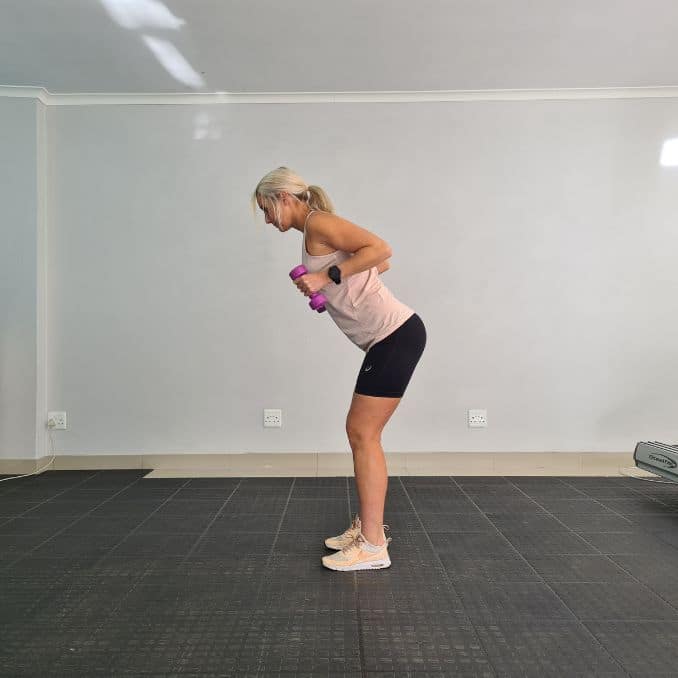 |
 |
Triceps Extension
Benefits of Tricep Extension
Tricep kickbacks, known as triceps extensions, have become increasingly popular as a workout focusing mainly on the muscles at the back of your upper arm. You extend your arm backward while gripping a dumbbell or resistance band during this exercise. Despite its apparent simplicity, triceps extensions offer significant benefits that greatly enhance your workout and overall fitness regimen.
-
Targeting and Strengthening the Tricep Muscles
Triceps muscles extend the elbow joint and facilitate various pushing movements. They help build muscle strength and improve muscle endurance. Engaging these muscles over an extended duration compels them to work harder to build muscle and adapt to increased stress levels.
-
Versatility
This exercise can be performed using dumbbells, resistance bands, or cables in a gym setting. You have the freedom to effortlessly modify the level of intensity according to your fitness level and desired objectives. Whether you are a complete beginner only seeking to develop foundational arm strength or an advanced athlete aiming for sculpted arms with enhanced power and definition, tricep kickbacks can be tailored accordingly.
By regularly including this exercise in your fitness routine while maintaining proper form and gradually using fewer reps without increasing weight or tension over time, you can reap the rewards of stronger and more toned tricep muscles, muscular strength, and improved functional performance in various upper body movements.
3. Bent Over Fly's
For this exercise, use dumbbells or cans of soup for added weight.
Begin in an upright standing position with your feet hip-width apart, maintaining good alignment with your head, shoulders, hips, and legs. Hold a dumbbell in each hand. Bend your knees and hinge through your hips. Engage your core and open your arms out to the sides, ideally up to shoulder height. Slowly lower your arms down to the starting position and repeat the movement. Complete 10 reps. Incorporate bent over the fly into your beginner home workout routine to strengthen your upper back muscles and enhance overall posture and shoulder stability.
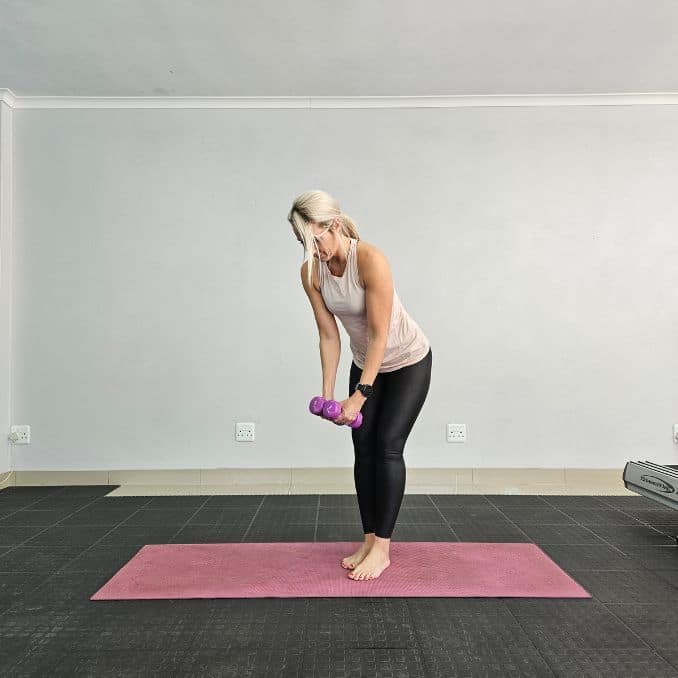 |
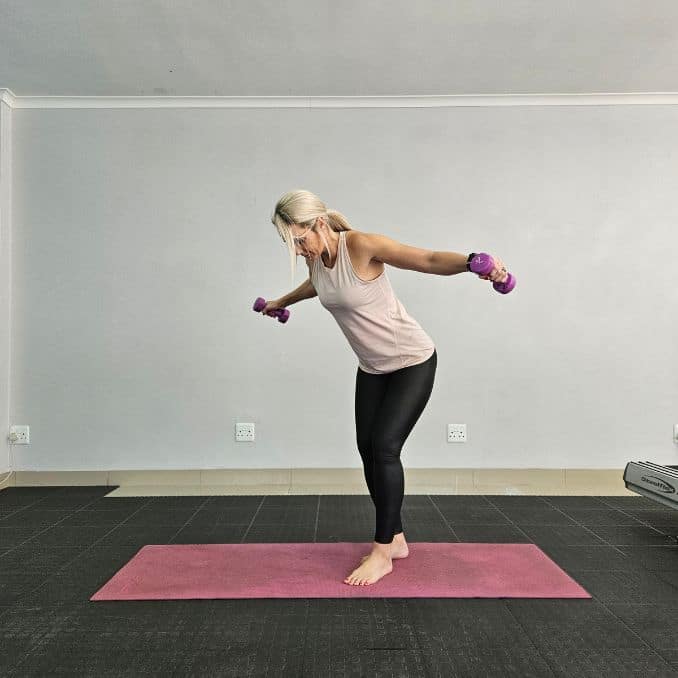 |
Bent Over Fly’s
Benefits of Bent Over Fly's
Bent Over Fly's exercise is a fantastic way to target and strengthen your upper back muscles, specifically the rhomboids and rear deltoids. This exercise is often done with the use of dumbbells or resistance bands. It involves bending through the hips with a slight bend in the knees, then lifting the weights to the sides in a wide sweeping motion.
-
Improve Posture
Most of us spend hours hunched over our desks or looking down at our phones, leading to rounded shoulders and a weakened upper back. By incorporating Bent Over Fly into your workouts, you can help counteract this poor posture and strengthen the muscles that support a healthy, upright stance.
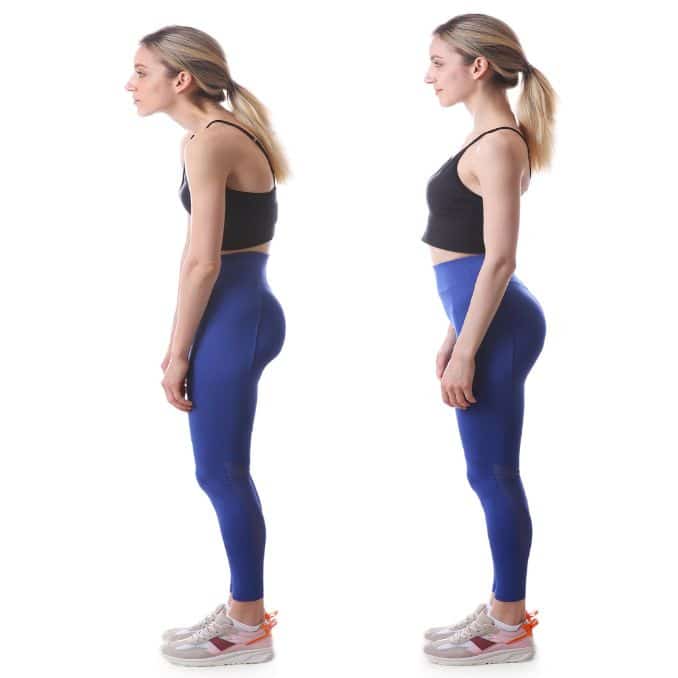
-
Improve Shoulder Stability
The rear deltoids pull the shoulder blades back and down, which is crucial for maintaining proper shoulder alignment and preventing injuries. Regularly performing Bent Over Fly can strengthen these muscles and improve overall shoulder stability.
4. Bicep Curls
For this exercise, use dumbbells or cans of soup for added weight.
Begin in an upright standing position with your feet hip-width apart, maintaining good alignment with your head, shoulders, hips, and legs. Hold a dumbbell in each hand and place your hands at your sides. Engage your core and curl your arms to bring the dumbbells to shoulder level. Slowly lower your arms down to the starting position and repeat the movement. Complete 10 reps. Incorporate bicep curls into your beginner home workout routine to strengthen and tone your biceps, contributing to balanced upper-body muscle development.
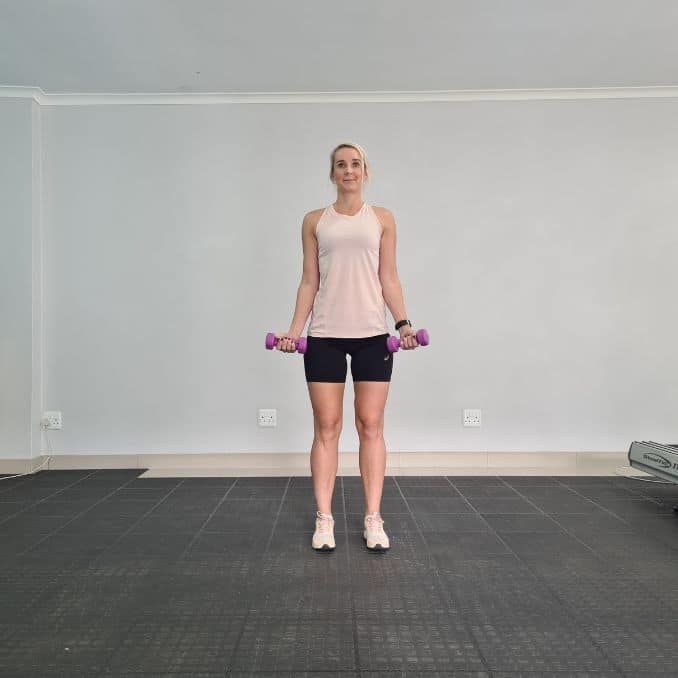 |
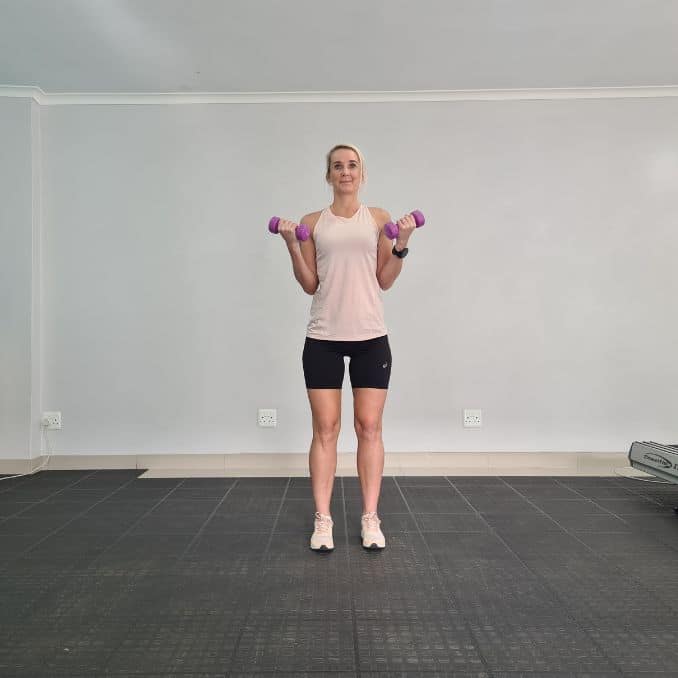 |
Bicep Curls
Benefits of Bicep Curls
Bicep curls are widely recognized as one of the most popular exercises for fortifying and toning the muscles in your upper arms. If you're passionate about staying fit or starting to prioritize your fitness, incorporating bicep curls into your routine can yield diverse benefits to achieving your fitness goals.
-
Functional Upper Body Strength
Strong biceps are essential for various daily activities and functional movements, such as lifting and carrying objects, pulling, and even pushing. Improving bicep strength through curls can enhance your ability to perform these tasks more effectively.
-
Improved Grip Strength
Bicep curls require a firm grip on the weights, and this helps improve grip strength. A stronger grip is beneficial in many other exercises and daily activities that involve holding onto objects, including various sports activities.
-
Muscular Balance
Bicep curls can help create a balanced upper body appearance. Many people focus on chest and shoulder exercises, neglecting their biceps. Including bicep curls in your workout routine ensures a balanced development of your upper body muscles.
-
Injury Prevention
Strengthening muscle mass in the biceps can contribute to better shoulder stability and overall upper-body mechanics. This can reduce the risk of shoulder and arm injuries during physical activities or sports.
-
Versatility
Bicep curls are versatile exercises that can be performed using different equipment, such as dumbbells, barbells, resistance bands, or cable machines. You can select the option that matches your preference or is compatible with your available equipment.
-
Muscle Engagement
Bicep curls target the biceps and engage other muscles in the upper body, such as the forearms and the brachialis (a muscle underneath the biceps). This compound effect provides a more comprehensive workout for the upper body fat arm muscles.
-
Time-Efficient
Bicep curls are relatively simple and quick to perform, making them a time-efficient addition to your workout routine. They can be easily incorporated into a broader upper-body or full-body strength training program.
Remember to maintain proper form during bicep curls to minimize the risk of injury and maximize the benefits. Avoid using excessive momentum or swinging to lift the weights, and control the movement throughout the exercise. If you're new to resistance training or have any health concerns, it's advisable to consult with a fitness professional to ensure proper exercise selection and technique.
5. Shoulder External Rotation
For this exercise, use dumbbells or cans of soup for added weight.
Begin in an upright standing position with your feet hip-width apart, maintaining good alignment with your head, shoulders, hips, and legs. Hold a dumbbell in each hand. Bend your arms, keeping your upper arm aligned with your body as you bring both dumbbells together in front. Engage your core and rotate both arms out to the sides. Rotate your arms back to the starting position and repeat the movement. Complete 8 reps. Including shoulder external rotations in your beginner home workout routine can help strengthen your rotator cuff muscles and improve shoulder stability.
 |
 |
Shoulder External Rotation
Benefits of Shoulder External Rotation
Shoulder external rotation is an excellent exercise that offers a multitude of advantages for individuals at any level of fitness. Whether you are an athlete aiming to enhance your performance or someone recovering from a shoulder injury, incorporating shoulder external rotation into your workout routine can prove highly beneficial.
-
Strengthening the Rotator Cuff
Shoulder external rotation targets the rotator cuff muscles, including the infraspinatus and teres minor, which are crucial in stabilizing the shoulder joint. Strengthening these muscles helps improve shoulder stability and reduces the risk of injuries, such as rotator cuff tears.
-
Improving Shoulder Mobility
Performing shoulder external rotation exercises helps enhance the range of motion in the shoulder joint. This increased mobility is beneficial for everyday activities and sports performance.
-
Preventing Shoulder Impingement
Shoulder impingement occurs when the structures in the shoulder, such as tendons or bursae, get compressed or pinched during certain movements. Strengthening the rotator cuff through external rotation exercises can help prevent impingement and related shoulder issues.
-
Correcting Muscle Imbalances
In many individuals, the muscles responsible for shoulder internal rotation tend to be stronger than those responsible for external rotation. This imbalance can lead to shoulder instability and injuries. Focusing on external rotation exercises helps correct this imbalance, promoting better shoulder function.
-
Rehabilitation after Shoulder Injuries
Shoulder external rotation exercises are often prescribed during rehabilitation after shoulder injuries or surgeries. They aid in strengthening the affected muscles, restoring the range of motion, and facilitating recovery.
-
Shoulder Health in Overhead Movements
People who frequently engage in overhead activities, such as weightlifting, tennis serves, or overhead presses, can benefit from shoulder external rotation exercises to maintain shoulder health and prevent injuries.
-
Posture Improvement
Strengthening the rotator cuff through external rotation can help improve overall shoulder posture, reducing the risk of developing conditions like rounded shoulders or forward head posture.
6. Lateral Arm Raise
For this exercise, use dumbbells or cans of soup for added weight.
Begin in an upright standing position with your feet hip-width apart, maintaining good alignment with your head, shoulders, hips, and legs. Hold a dumbbell in each hand. Engage your core and raise your arms out to the sides, ideally up to shoulder height. Slowly lower
your arms back down to the starting position and repeat the movement. Complete 10 reps.
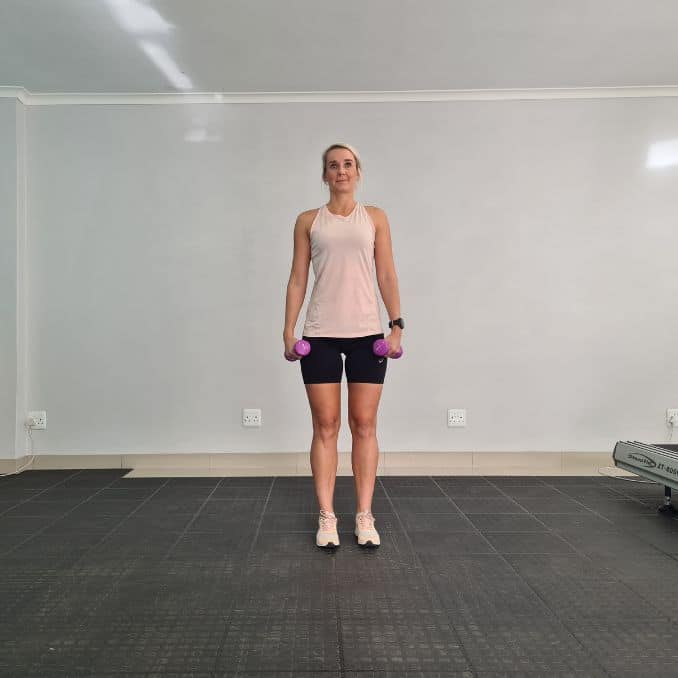 |
 |
Lateral Arm Raise
Benefits of Lateral Arm Raises
Lateral arm raises offer many advantages for your overall fitness and well-being. Whether you're an avid gym-goer or simply aiming to sculpt your arms, incorporating lateral arm raises into your workout routine can yield noteworthy results. In this article, I will delve into the benefits of lateral arm raises and why they should be considered an essential part of your fitness regimen.
-
Strengthens the Deltoid Muscles
These muscles shape the roundness and build strength of your shoulders. You specifically engage the lateral deltoids responsible for lifting your arms sideways by performing lateral arm raises. Strengthening these muscles enhances shoulder appearance while improving upper body strength.
-
Improved Posture
Many individuals spend prolonged periods sitting at desks, often leading to rounded shoulders and a hunched back posture. By strengthening the deltoids via lateral arm raises, you can counteract this slouched position and promote an upright stance, positively impacting physical appearance and overall health.
-
Improves stability in Daily Activities
They engage multiple muscle groups simultaneously while maintaining balance throughout each repetition. In conclusion, adding lateral arm raises to your workout regimen brings forth numerous advantages such as targeted muscle strengthening in the shoulders resulting in enhanced appearance along with improved upper body strength; additionally promoting good posture by countering rounded shoulders caused by sedentary lifestyles; finally contributing to increased stability during various daily tasks due to engaging multiple muscle groups concurrently.
Additional Workouts (on the floor)
1. Side Lying Hip Abduction
It's a good workout that targets the hip abductor muscles, primarily the gluteus medius and gluteus minimus. This simple yet effective movement helps to strengthen and stabilize the hips, enhancing overall lower body function and preventing potential injuries.
Lie on your side with your head resting on your arm, ideally keeping your shoulders, hips, and legs in a straight line. Engage your core and slowly lift your right leg as high as you comfortably can, feeling the contraction in your outer hip. Make sure to lead the movement with your heel and avoid rolling your hips backward. Hold the position for a brief moment to maximize the engagement of the muscles. Lower your leg in a smooth, controlled manner to return to the starting position. Repeat the movement on the opposite leg.
2. Side Plank

The side plank is another home workout for strengthening the core, particularly the obliques and the muscles along the side of your torso. It also engages the muscles in your shoulders, hips, knees, and legs, making it a highly effective full-body exercise.
Move into a forearm plank position, maintaining good alignment with your head, shoulder, hips, and legs. Contract your core and rotate your body to one side to move into a side plank position, keeping your feet together and placing your opposite hand on your hip. Hold this position for 30 seconds. Take several deep belly breaths in through your nose and out through your mouth. Relax and return to the starting position. Switch sides to repeat the movement.
Conclusion
Exercising at home saves time and resources by eliminating the need to go to the gym and personal trainers. It offers a private and comfortable space to exercise, boosting confidence and motivation. Working out at home allows you to customize your routine and fit it into your schedule, making it more likely to become a long-term habit. Now is the perfect time to start or continue your fitness journey with home workouts.
Start your journey towards a healthier and happier you by transforming your living room, backyard, or any available space into your fitness haven. Use household items as exercise equipment and enjoy the versatility they offer. Share your progress with loved ones and motivate them to join you on this transformative journey with small steps and gradually increase your routine. Remember, progress is a journey, not a destination. Stay motivated, set achievable goals, and celebrate your successes. Every small effort adds up, and you have the strength within you to make a positive change and lose weight together. So, let's lace up our shoes, get started, grab those water bottles, and embark on this weight-off adventure together. Here's to a fitter, healthier, and more vibrant life ahead!

